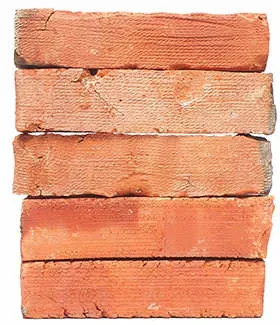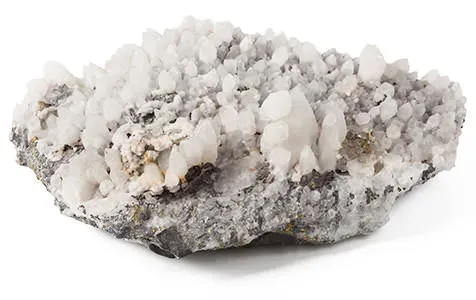 Dolomite is a mineral that is rarely faceted for jewelry because of its softness. However the stone does have very important industrial uses, such as its use in manufacturing refractory bricks for furnace linings. Dolomite was named after the French mineralogist D. Dolomieu (1750-1801) who first described the mineral in 1798 during a visit to Egypt with Napoleon Bonaparte. Dolomite is composed of calcium and magnesium carbonate, and is quite similar to calcite. There are a few different varieties of dolomite. Pale brown, gray, or white dolomite with a pearly luster is called pearl spar. Brown dolomite, colored by iron, is called bitter spar. Dolomite crystals can also be colorless, yellow, or pink. Dolomite is often found with distinctive curved faces that combine into distinctive saddle-shaped growths. The stone rates only a 3.5 to 4 on the hardness scale. It is brittle, with perfect cleavage. It has a vitreous to pearly luster, and is transparent to translucent. While dolomite is not usually cut for jewelry, it is sometimes given a step cut and faceted for collectors.
Dolomite is a mineral that is rarely faceted for jewelry because of its softness. However the stone does have very important industrial uses, such as its use in manufacturing refractory bricks for furnace linings. Dolomite was named after the French mineralogist D. Dolomieu (1750-1801) who first described the mineral in 1798 during a visit to Egypt with Napoleon Bonaparte. Dolomite is composed of calcium and magnesium carbonate, and is quite similar to calcite. There are a few different varieties of dolomite. Pale brown, gray, or white dolomite with a pearly luster is called pearl spar. Brown dolomite, colored by iron, is called bitter spar. Dolomite crystals can also be colorless, yellow, or pink. Dolomite is often found with distinctive curved faces that combine into distinctive saddle-shaped growths. The stone rates only a 3.5 to 4 on the hardness scale. It is brittle, with perfect cleavage. It has a vitreous to pearly luster, and is transparent to translucent. While dolomite is not usually cut for jewelry, it is sometimes given a step cut and faceted for collectors.
 Dolomite is found in metamorphic marble rock and occurs as a gangue mineral in veins with sphalerite or galena. Its most important occurrence is as a rock-forming mineral in carbonate rocks. Sedimentary dolomite rock is called dolomitic limestone, magnesian limestone, and dolostone. This rock is composed almost entirely of the mineral dolomite, but has small amounts of calcite in it. Sedimentary dolomite rock is found worldwide in shades of white, pink, cream, brown and gray. It is used for industrial purposes - to make cement, as insulating materials, and as a building stone. It is also used as an antacid and is a source of magnesium oxide.
Dolomite is found in metamorphic marble rock and occurs as a gangue mineral in veins with sphalerite or galena. Its most important occurrence is as a rock-forming mineral in carbonate rocks. Sedimentary dolomite rock is called dolomitic limestone, magnesian limestone, and dolostone. This rock is composed almost entirely of the mineral dolomite, but has small amounts of calcite in it. Sedimentary dolomite rock is found worldwide in shades of white, pink, cream, brown and gray. It is used for industrial purposes - to make cement, as insulating materials, and as a building stone. It is also used as an antacid and is a source of magnesium oxide.
 The most highly prized dolomite crystals come from the Freiberg and Schneeberg mines in Germany; Binnenthal, Switzerland, Cornwall and Cumbria in England, and various locations around the United States. Deposits are also found in Brosso and Traversella in Scotland; Piedmont, Italy; St. Eustache, Quebec, in Canada and Guanajuato, Mexico. It also occurs in various locations around Brazil, Saudi Arabia, Spain, Austria, and the Czech Republic. In the United States, dolomite occurs in Vermont, New York, New Jersey, North Carolina, Missouri, Wyoming, Iowa, and Colorado.
The most highly prized dolomite crystals come from the Freiberg and Schneeberg mines in Germany; Binnenthal, Switzerland, Cornwall and Cumbria in England, and various locations around the United States. Deposits are also found in Brosso and Traversella in Scotland; Piedmont, Italy; St. Eustache, Quebec, in Canada and Guanajuato, Mexico. It also occurs in various locations around Brazil, Saudi Arabia, Spain, Austria, and the Czech Republic. In the United States, dolomite occurs in Vermont, New York, New Jersey, North Carolina, Missouri, Wyoming, Iowa, and Colorado.
 Dolomite is a stone that can bring the wearer a great amount of calm. It does so by helping the wearer to open his heart and trust himself, bringing confidence, self-love, and inner certainty. Medically, dolomite has been said to aid osteoporosis, broken bones, tooth and jaw problems, insomnia, nightmares, irregular sleep patterns, and night fears. It is also said to be a good stone for those who are about to become parents, bringing inner calm at a time when everything seems overwhelming and unmanageable.
Dolomite is a stone that can bring the wearer a great amount of calm. It does so by helping the wearer to open his heart and trust himself, bringing confidence, self-love, and inner certainty. Medically, dolomite has been said to aid osteoporosis, broken bones, tooth and jaw problems, insomnia, nightmares, irregular sleep patterns, and night fears. It is also said to be a good stone for those who are about to become parents, bringing inner calm at a time when everything seems overwhelming and unmanageable.